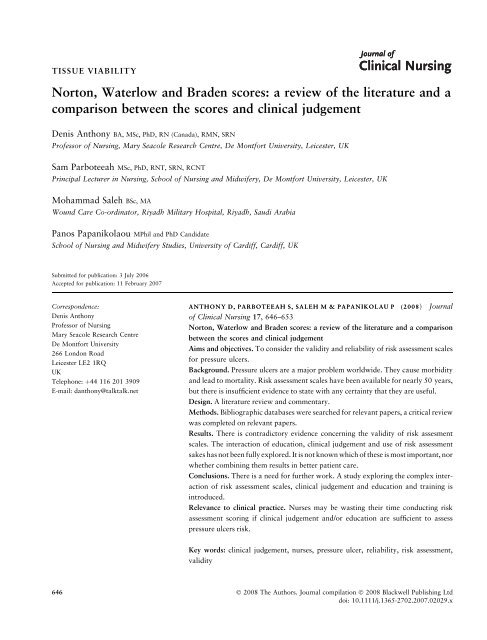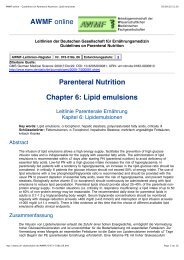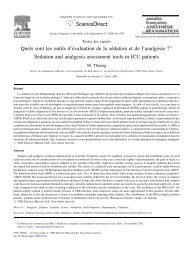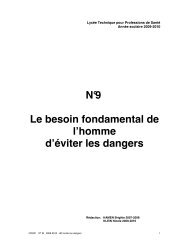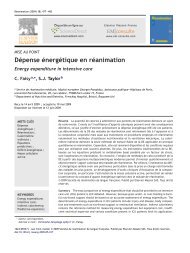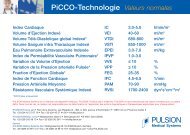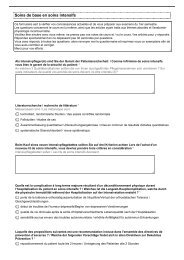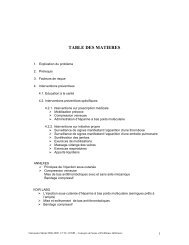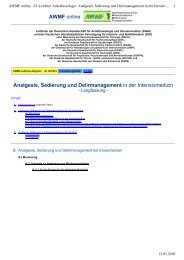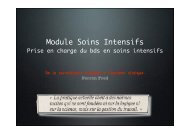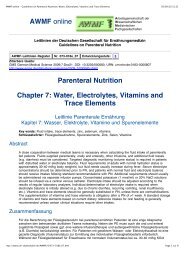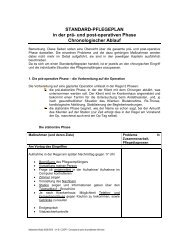Norton, Waterlow and Braden scores: a review of ... - Cardiff University
Norton, Waterlow and Braden scores: a review of ... - Cardiff University
Norton, Waterlow and Braden scores: a review of ... - Cardiff University
Create successful ePaper yourself
Turn your PDF publications into a flip-book with our unique Google optimized e-Paper software.
TISSUE VIABILITY<br />
<strong>Norton</strong>, <strong>Waterlow</strong> <strong>and</strong> <strong>Braden</strong> <strong>scores</strong>: a <strong>review</strong> <strong>of</strong> the literature <strong>and</strong> a<br />
comparison between the <strong>scores</strong> <strong>and</strong> clinical judgement<br />
Denis Anthony BA, MSc, PhD, RN (Canada), RMN, SRN<br />
Pr<strong>of</strong>essor <strong>of</strong> Nursing, Mary Seacole Research Centre, De Montfort <strong>University</strong>, Leicester, UK<br />
Sam Parboteeah MSc, PhD, RNT, SRN, RCNT<br />
Principal Lecturer in Nursing, School <strong>of</strong> Nursing <strong>and</strong> Midwifery, De Montfort <strong>University</strong>, Leicester, UK<br />
Mohammad Saleh BSc, MA<br />
Wound Care Co-ordinator, Riyadh Military Hospital, Riyadh, Saudi Arabia<br />
Panos Papanikolaou MPhil <strong>and</strong> PhD C<strong>and</strong>idate<br />
School <strong>of</strong> Nursing <strong>and</strong> Midwifery Studies, <strong>University</strong> <strong>of</strong> <strong>Cardiff</strong>, <strong>Cardiff</strong>, UK<br />
Submitted for publication: 3 July 2006<br />
Accepted for publication: 11 February 2007<br />
Correspondence:<br />
Denis Anthony<br />
Pr<strong>of</strong>essor <strong>of</strong> Nursing<br />
Mary Seacole Research Centre<br />
De Montfort <strong>University</strong><br />
266 London Road<br />
Leicester LE2 1RQ<br />
UK<br />
Telephone: þ44 116 201 3909<br />
E-mail: danthony@talktalk.net<br />
ANTHONY D, PARBOTEEAH S, SALEH M & PAPANIKOLAU P (2008) Journal<br />
<strong>of</strong> Clinical Nursing 17, 646–653<br />
<strong>Norton</strong>, <strong>Waterlow</strong> <strong>and</strong> <strong>Braden</strong> <strong>scores</strong>: a <strong>review</strong> <strong>of</strong> the literature <strong>and</strong> a comparison<br />
between the <strong>scores</strong> <strong>and</strong> clinical judgement<br />
Aims <strong>and</strong> objectives. To consider the validity <strong>and</strong> reliability <strong>of</strong> risk assessment scales<br />
for pressure ulcers.<br />
Background. Pressure ulcers are a major problem worldwide. They cause morbidity<br />
<strong>and</strong> lead to mortality. Risk assessment scales have been available for nearly 50 years,<br />
but there is insufficient evidence to state with any certainty that they are useful.<br />
Design. A literature <strong>review</strong> <strong>and</strong> commentary.<br />
Methods. Bibliographic databases were searched for relevant papers, a critical <strong>review</strong><br />
was completed on relevant papers.<br />
Results. There is contradictory evidence concerning the validity <strong>of</strong> risk assesment<br />
scales. The interaction <strong>of</strong> education, clinical judgement <strong>and</strong> use <strong>of</strong> risk assessment<br />
sakes has not been fully explored. It is not known which <strong>of</strong> these is most important, nor<br />
whether combining them results in better patient care.<br />
Conclusions. There is a need for further work. A study exploring the complex interaction<br />
<strong>of</strong> risk assessment scales, clinical judgement <strong>and</strong> education <strong>and</strong> training is<br />
introduced.<br />
Relevance to clinical practice. Nurses may be wasting their time conducting risk<br />
assessment scoring if clinical judgement <strong>and</strong>/or education are sufficient to assess<br />
pressure ulcers risk.<br />
Key words: clinical judgement, nurses, pressure ulcer, reliability, risk assessment,<br />
validity<br />
646 Ó 2008 The Authors. Journal compilation Ó 2008 Blackwell Publishing Ltd<br />
doi: 10.1111/j.1365-2702.2007.02029.x
Tissue viability<br />
Introduction<br />
This paper is primarily concerned with answering the<br />
questions ‘are risk assessment scales (RASs) valid <strong>and</strong><br />
reliable’ <strong>and</strong> ‘which <strong>of</strong> these clinical judgement <strong>and</strong> RASs<br />
are superior’ The path to answering these related questions<br />
commences with an introduction to the subject area, then<br />
describes the three most common RASs. Other <strong>review</strong>s <strong>of</strong><br />
RASs are then described to show the gap in knowledge which<br />
this <strong>review</strong> explores. To evaluate validity the items included<br />
in RASs are next identified <strong>and</strong> how these are used to<br />
compute an overall score. Reliability is next addressed as<br />
RASs are normally completed not only more than once, but<br />
by more than one clinician. Evaluation explores validity,<br />
reliability <strong>and</strong> outcomes <strong>and</strong> studies evaluating RASs are next<br />
examined. How RASs are actually used <strong>and</strong> whether they are<br />
better than clinical judgement is next considered. Finally<br />
problems in comparing clinical judgement <strong>and</strong> RASs are<br />
stated <strong>and</strong> suggestions for new work <strong>of</strong>fered.<br />
Search strategy<br />
Cumulative index to nursing <strong>and</strong> allied health literature<br />
(CINAHL) was searched using medical subject headings<br />
(MeSH) keywords ‘pressure ulcer’(PU) <strong>and</strong> ‘risk assessment’<br />
for all papers 1960–May 2006 which gave 531 papers. Limiting<br />
to research or <strong>review</strong> papers gave 253. The earliest paper<br />
located was 1991 <strong>and</strong> there were further papers each subsequent<br />
year, with a trend <strong>of</strong> increasing numbers in later years. All<br />
available abstracts were read <strong>and</strong> assessed for relevance. Where<br />
no abstract was available the title was examined to determine<br />
the relevance. Full text papers that were evaluated to be<br />
relevant were obtained where possible. Additional papers that<br />
were known to the authors were also used.<br />
Inclusion criteria<br />
Papers that used quantitative methods to evaluate RASs. All<br />
papers that considered sensitivity, specificity, receiver operating<br />
characteristic, inter- <strong>and</strong> intra-observer reliability.<br />
Exclusion criteria<br />
Papers with no evaluation <strong>of</strong> RASs, for example papers<br />
employing a RAS within a trial where the validity, reliability<br />
or precision <strong>of</strong> the RAS was not evaluated. Editorials <strong>and</strong><br />
journalistic articles with no primary data were also excluded.<br />
Results<br />
Pressure ulcers are not a new phenomenon. The first<br />
reference to PUs by a nurse that the authors can find was<br />
Comparison between <strong>scores</strong> <strong>and</strong> clinical judgement<br />
in 1899 when Amy Hughes, a nursing sister, wrote a section<br />
in a medical book outlining PU prevention (Hughes 1899).<br />
She advocated vigorous massage <strong>of</strong> the buttocks, thought<br />
then to be appropriate, now thought to be a disastrous<br />
strategy. Dyson showed, in a sample <strong>of</strong> 200 patients, a 38%<br />
reduction in incidence <strong>of</strong> PUs in those who had not received<br />
massage (Dyson 1978). Doctors had discussed PUs earlier; a<br />
BMJ editorial in 1873 discussed PUs (Anonymous 1873),<br />
stating they should be left to dry out. This is also now<br />
thought to be the wrong approach, as Winter showed that<br />
sores heal much faster under an occlusive dressing (Winter<br />
1962). The same year James Paget gave advice on how to<br />
treat them that was surprisingly similar to modern ideas,<br />
advocating diet as being crucial (Paget 1873), though his<br />
prescription <strong>of</strong> restricting meat <strong>and</strong> giving a little wine<br />
would be seen as suboptimal today. However, there are<br />
earlier references; PUs were described in the sixteenth<br />
century by Pare (Levine 1992) <strong>and</strong> Fabricus (Torrance<br />
1983); Hildnaus used term decubitus in 1590 (Guggisberg<br />
et al. 1992); they have even been seen in Egyptian mummies<br />
(Torrance 1983).<br />
There are many papers on prevention <strong>of</strong> PUs, <strong>and</strong> several<br />
clinical guidelines are available from reputable agencies that<br />
<strong>of</strong>fer consistent <strong>and</strong> evidence based advice, e.g. the National<br />
Institute <strong>of</strong> Clinical Excellence (available from http://<br />
www.nelh.nhs.uk).<br />
One might imagine, given the long history <strong>of</strong> PUs <strong>and</strong> the<br />
current availability <strong>of</strong> quality advice, nurses would be very<br />
familiar with prevention <strong>of</strong> PUs, <strong>and</strong> PU prevalence would be<br />
very low. However, the scale <strong>of</strong> the problem is huge; the<br />
European Pressure Ulcer Advisory Panel study found an<br />
overall prevalence <strong>of</strong> PUs in hospital patients in Europe <strong>of</strong><br />
18%, depending on patient group <strong>and</strong> care environment<br />
(Clark et al. 2004).<br />
Why this remains the case is explicable for two related<br />
reasons:<br />
1 Nurses are not always knowledgeable about PU prevention;<br />
for example, one audit showed deficiencies in knowledge <strong>of</strong><br />
the staff <strong>and</strong> care given to prevent <strong>and</strong> manage PUs (Jones<br />
et al. 2003). Even in 2005, nurses in one Turkish study were<br />
still using massage <strong>and</strong> inflatable rings for PU prevention<br />
(Acaroglu & Sendir 2005), nearly 30 years after massage<br />
was generally considered dangerous <strong>and</strong> at least 20 after<br />
inflatable rings were similarly viewed. Inappropriate PU<br />
prevention advice was evident in the UK decades after it was<br />
widely discredited in the academic press (Anthony 1996).<br />
2 PU prevalence <strong>and</strong> incidence are under-reported <strong>and</strong> thus<br />
nurses may not be aware <strong>of</strong> the true scale <strong>of</strong> the problem<br />
(Gunningberg & Ehrenberg 2004). If the true scale <strong>of</strong><br />
the problem was evident nurses would presumably more<br />
Ó 2008 The Authors. Journal compilation Ó 2008 Blackwell Publishing Ltd 647
D Anthony et al.<br />
actively educate themselves on the appropriate prevention<br />
methods.<br />
If nurses are to prevent PUs, clearly they need to be aware<br />
<strong>of</strong> what causes them <strong>and</strong> those risk factors that make them<br />
more likely to occur so preventative actions may be taken.<br />
Known risk factors have been used to create RASs which are<br />
described below.<br />
Examples <strong>of</strong> RASs<br />
<strong>Norton</strong> score<br />
In the late 1950s <strong>and</strong> early 1960s a team working in London,<br />
including doctors <strong>and</strong> nurses were working on developing a<br />
RAS. Exton-Smith <strong>and</strong> Sherwin had shown that patients who<br />
move during sleep at least 20 times per night were less likely<br />
to develop PUs than those who moved less (Exton-Smith &<br />
Sherwin 1961). Mobility was clearly one factor, but in 1962<br />
several other factors were added to mobility; incontinence,<br />
activity, mental state <strong>and</strong> physical condition to create the first<br />
RAS, the <strong>Norton</strong> score (<strong>Norton</strong> et al. 1962). The score was<br />
designed so that the lower the score the higher the risk <strong>of</strong><br />
developing PUs.<br />
<strong>Waterlow</strong> score<br />
At the time <strong>of</strong> <strong>Norton</strong>’s prominence in care units for older<br />
people in the 1980s (Spenceley 1988, Girvin & Griffiths-<br />
Jones 1989) a new tool, the <strong>Waterlow</strong> score was designed as a<br />
practical aid to the preventive aids <strong>and</strong> treatments available<br />
whilst at the same time promoting awareness <strong>of</strong> the causes <strong>of</strong><br />
PUs <strong>and</strong> determined risk (<strong>Waterlow</strong> 1985,1988,1991). The<br />
<strong>Waterlow</strong> score is composed <strong>of</strong> the following risk areas;<br />
build/weight, continence, skin type, mobility, sex/age,<br />
appetite, tissue malnutrition, neurological deficit, surgery/<br />
trauma, specific medication <strong>and</strong> additional risk factors (such<br />
as smoking). The higher the score, the higher the risk <strong>of</strong> PU<br />
formation.<br />
The <strong>Braden</strong> score<br />
Around the same time as <strong>Waterlow</strong> devised her score, a<br />
further assessment tool, the <strong>Braden</strong> score, was being<br />
developed based upon the literature exploring the aetiology<br />
<strong>of</strong> PU formation. <strong>Braden</strong> <strong>and</strong> Bergstrom found the critical<br />
factors to be intensity <strong>and</strong> duration <strong>of</strong> pressure <strong>and</strong> tolerance<br />
to pressure (<strong>Braden</strong> & Bergstrom 1987). Other risk<br />
factors such as mobility, skin moisture <strong>and</strong> nutritional<br />
status were also incorporated. Each sub-scale has three to<br />
four levels all with an operational definition. Like the<br />
<strong>Norton</strong> score, low values are supposed to denote high risk<br />
<strong>of</strong> PU. Patients are deemed to be ‘at risk’ with a score <strong>of</strong><br />
16 or less.<br />
Reviews <strong>of</strong> RASs<br />
There are many <strong>review</strong>s <strong>of</strong> RASs (Edwards 1994, Smith et al.<br />
1995, Deeks 1996, Stotts 1999, Moore & Pitman 2000,<br />
Tarpey et al. 2000, Vap & Dunaye 2000, Defloor &<br />
Grypdonck 2004, Price et al. 2005, Thompson 2005, Maylor<br />
2006). These <strong>review</strong>s compare <strong>and</strong> contrast the various RASs,<br />
but there is no RAS that is clearly the best. As <strong>of</strong> 2005, there<br />
were over 40 different assessment tools (Thompson 2005). In<br />
part, the proliferation <strong>of</strong> RASs is because <strong>of</strong> the differing<br />
needs <strong>of</strong> different clinical areas; for example, neither the<br />
<strong>Waterlow</strong> nor <strong>Braden</strong> (both designed for hospital patients)<br />
seems to be suitable for wheelchair users in the community<br />
(Anthony et al. 1998). However, even in specific clinical<br />
areas, there is no agreed best RAS; for example, in paediatrics<br />
there are several competing RASs, <strong>and</strong> eight published risk<br />
assessment tools have been identified (Willock 2006). While<br />
some validation studies have been performed on the more<br />
common RASs, there are few studies that compare the RASs<br />
on the same population.<br />
There has long been concern over the lack <strong>of</strong> conclusive<br />
data regarding the comparative merits <strong>of</strong> one tool over<br />
another (Flanagan 1995). However, Clark <strong>and</strong> Farrar found<br />
if threshold <strong>scores</strong> were set correctly, the choice <strong>of</strong> tool was<br />
relatively unimportant (Clark & Farra 1991). Whilst<br />
difficulties still remain as to choice <strong>of</strong> instrument based on<br />
evaluations <strong>of</strong> their respective sensitivity, specificity <strong>and</strong><br />
reliability <strong>scores</strong>, some have begun to question the application<br />
<strong>of</strong> the criteria with which judgements are made as to the<br />
efficacy <strong>and</strong> applicability <strong>of</strong> such a tool.<br />
For example <strong>Waterlow</strong> has responded to some <strong>of</strong> the<br />
criticisms made regarding the validity <strong>and</strong> reliability <strong>of</strong> her<br />
tool (<strong>Waterlow</strong> 1996). She rejects the way validity is being<br />
used by ‘trying to tie dubious measurements <strong>of</strong> specificity <strong>and</strong><br />
sensitivity’ <strong>and</strong> considers the definition <strong>of</strong> validity as being<br />
‘sound, well-grounded’ more appropriate. Similarly, she<br />
argues how ‘reliability’ will be achieved by education <strong>and</strong><br />
use over time, producing a reduction in pressures sores.’<br />
Furthermore, she is concerned over the use <strong>of</strong> the word<br />
‘predict’ as ‘at worst the word predict takes RASs out <strong>of</strong> their<br />
role <strong>of</strong> aids to prevention <strong>and</strong> puts them into the realm <strong>of</strong><br />
prophesying pressure ulcer development’ (<strong>Waterlow</strong> 1996,<br />
p. 58). This has been reiterated by Shakespeare who states<br />
that the risk score is not for the prediction <strong>of</strong> sore development,<br />
it is for the assessment <strong>and</strong> prediction <strong>of</strong> risk which can<br />
be influenced by many factors such as the quality <strong>of</strong> nursing<br />
care <strong>and</strong> medical advances (Shakespeare 1994).<br />
If a high RAS score causes greater prevention measures,<br />
sensitivity will be lower, but what is happening is that, while<br />
the RAS appears to be poorer at prediction, it is in fact having<br />
648 Ó 2008 The Authors. Journal compilation Ó 2008 Blackwell Publishing Ltd
Tissue viability<br />
a beneficial effect on reducing PU incidence <strong>and</strong> is working<br />
well. For example, appropriate interventions <strong>and</strong> high quality<br />
nursing care could influence the incidence <strong>of</strong> PUs which in<br />
turn would show the RAS to be poorly performing with<br />
respect to sensitivity <strong>and</strong> specificity (Edwards 1996). To<br />
determine true sensitivity <strong>and</strong> specificity would mean withholding<br />
preventive intervention <strong>and</strong> allowing PUs to develop<br />
in vulnerable patients, which would be ethically unacceptable<br />
(Flanagan 1995).<br />
Which risk factors should be included<br />
There are many factors other than those identified in the most<br />
common RASs (<strong>Norton</strong>, <strong>Waterlow</strong> <strong>and</strong> <strong>Braden</strong>) located in<br />
literature, including ethnicity (Zollo et al. 1996), low blood<br />
pressure (Van Marum et al. 2000) <strong>and</strong> many other factors<br />
have been proposed. Indeed over 200 risk factors have been<br />
reported for PUs (Salzberg et al. 1999), but these are not all<br />
relevant to all client groups, for example cigarette smoking<br />
(Salzberg et al. 1996) will not apply to neonates.<br />
How are risk factors added to produce a score<br />
In the first RAS, <strong>Norton</strong>, the five risk factors were assigned a<br />
number from 1–4 where the lower the score the greater the<br />
risk. These were then summed to give a total score. The risk<br />
factors were assumed to be independent sub-<strong>scores</strong> <strong>of</strong> equal<br />
importance.<br />
<strong>Waterlow</strong> has different score ranges for the 11 sub-<strong>scores</strong>.<br />
Thus the risk factors were assumed to be independent but not<br />
<strong>of</strong> equal importance, though these ranges <strong>of</strong> values were not<br />
derived via any validation studies. In <strong>Waterlow</strong> high <strong>scores</strong><br />
are higher risk. <strong>Braden</strong> uses sub-<strong>scores</strong> 1–4 for sensory<br />
perception, moisture, activity, mobility, nutrition <strong>and</strong> 1–3 for<br />
friction/shear. Low <strong>scores</strong> are higher risk. All other RASs<br />
follow similar methods to compute a total score from sub<strong>scores</strong><br />
that are each measures <strong>of</strong> some risk factor. However,<br />
the weightings applied have rarely been subject to statistical<br />
analysis (for example regression analysis).<br />
In all RASs the sub-<strong>scores</strong> are assumed to be linear, i.e. they<br />
are simply added to give a total score. However, non-linear<br />
models are possible; to compute a total score one might apply<br />
various functions to each sub-score. For example one could<br />
use trigonometric functions (sine, cosine, tangent etc), powers<br />
(square, cube etc.), logarithms, exponential transforms <strong>and</strong><br />
many others. Common non-linear methods include artificial<br />
neural networks (ANNs). These consist <strong>of</strong> several layers <strong>of</strong><br />
units that attempt to model (in a simple way) how a brain<br />
(that can deal with non-linear behaviour) functions. In<br />
ANNs, input values (here sub-<strong>scores</strong>) are fed into the model<br />
which is trained to associate inputs to outputs (here presence<br />
<strong>of</strong> not <strong>of</strong> PUs). Once trained the ANN should be able to state<br />
Comparison between <strong>scores</strong> <strong>and</strong> clinical judgement<br />
how likely a patient will develop a PU given the sub-<strong>scores</strong>. In<br />
what the authors believe is the only study that considered<br />
non-linear modelling, linear modelling performed as well as<br />
ANNs, <strong>and</strong> so this may not be a serious limitation (Anthony<br />
et al. 2000).<br />
How many factors are used <strong>and</strong> how these are added has<br />
been a subject <strong>of</strong> few studies. One large study evaluated the<br />
Walsall score <strong>and</strong> pain was taken out as a factor as it did not<br />
seem to increase risk (Chaloner & Franks 2000). Other<br />
studies have shown removing sub-<strong>scores</strong> from <strong>Waterlow</strong><br />
allow similar or better prediction <strong>of</strong> incidence, but the sub<strong>scores</strong><br />
removed are different for various client groups<br />
(Anthony et al. 1998,2000). Thus, simply adding more<br />
factors is not necessarily going to improve a score, <strong>and</strong> the<br />
particular factors that are relevant vary across clinical areas.<br />
This does not mean the factors are not relevant to PU<br />
incidence in general, but this may not apply to some groups.<br />
For example in wheelchair users in the community, recent<br />
surgery (one sub-score <strong>of</strong> <strong>Waterlow</strong>) was not predictive <strong>of</strong><br />
PUs, but none <strong>of</strong> the population had surgery recently, so it<br />
clearly would not distinguish between those with <strong>and</strong> those<br />
with no PU.<br />
Are RASs reliable<br />
In some studies, they are shown to be so; for example, in a<br />
Spanish context the <strong>Braden</strong> <strong>and</strong> <strong>Norton</strong> both were reported<br />
to have good interobserver reliability (Caja et al. 1998), a<br />
clear requirement in any clinical area where more than one<br />
nurse may make assessments. <strong>Braden</strong> was also found to show<br />
good interobserver reliability in the Netherl<strong>and</strong>s (Bours et al.<br />
1999). The <strong>Waterlow</strong> score showed poor inter-observer<br />
reliability according to one study (Kelly 2005), though the<br />
statistical approach in that study was suboptimal (as exact<br />
agreement was measured <strong>and</strong> similarity would be preferred).<br />
It is possible that the <strong>Waterlow</strong> score is inherently less<br />
reliable than <strong>Norton</strong> or <strong>Braden</strong>, but other factors such as<br />
training on use <strong>of</strong> the tool will affect the reliability. For<br />
example there may be confusion over how to assess risk items<br />
such as nutrition (Kelly 2005).<br />
One particular problem that may appear to show a given<br />
RAS is unreliable is that the data collected may be inaccurate.<br />
For example almost half <strong>of</strong> <strong>Waterlow</strong> <strong>scores</strong> collected on a<br />
Hospital Information Support System were impossible given<br />
the patient’s age <strong>and</strong> gender, <strong>and</strong> it is not known that even the<br />
remaining data are accurate (Anthony et al. 2003). Further<br />
independent risk assessment showed poor agreement with<br />
nursing staff assessments (Scott & Newens 1999).<br />
Bridel found the <strong>Braden</strong> tool to be the most reliable <strong>and</strong><br />
that the ‘validity <strong>of</strong> the tool is generally good <strong>and</strong> compares<br />
favourably in comparison with <strong>Norton</strong> <strong>and</strong> <strong>Waterlow</strong> <strong>scores</strong>’<br />
Ó 2008 The Authors. Journal compilation Ó 2008 Blackwell Publishing Ltd 649
D Anthony et al.<br />
(Bridel 1993). However, Edwards is more cautious <strong>and</strong><br />
argues that the reliability <strong>of</strong> the instrument might be<br />
influenced by differences in the nursing pr<strong>of</strong>ession especially<br />
in primary care nursing in North America (Edwards 1994).<br />
Furthermore, Edwards points out how the assessments were<br />
not carried out on admission to acute medical or surgical<br />
settings <strong>and</strong> may also have affected the results.<br />
Evaluation <strong>of</strong> RASs<br />
The validity <strong>and</strong> reliability <strong>of</strong> the tool were not seen to have<br />
been fully addressed <strong>and</strong> Bridel further notes how information<br />
such as the number <strong>of</strong> patients ‘at risk’ <strong>and</strong> incidence <strong>of</strong><br />
PUs was omitted. Moreover, the reliability <strong>of</strong> the tool was<br />
judged as poor based on lack <strong>of</strong> comparative scoring,<br />
operational definitions <strong>and</strong> problems associated with interpretation<br />
<strong>of</strong> items (Bridel 1993).<br />
In terms <strong>of</strong> content validity, the <strong>Waterlow</strong> score has been<br />
found to be intuitively preferred by ward nurses as it contains<br />
more <strong>of</strong> the items associated with risk (Wardman 1991,<br />
Dealey 1994) although certain items have been criticised as<br />
being crude <strong>and</strong> ambiguous, especially in the assessment <strong>of</strong><br />
neurological disorders.<br />
The <strong>Waterlow</strong> score, it has been argued, will inevitably<br />
achieve high sensitivity as it contains a score for skin damage<br />
(Edwards 1996). The tendency <strong>of</strong> the <strong>Waterlow</strong> score to overpredict<br />
risk status (Bridel 1993) has caused some to challenge<br />
its usefulness in care settings such as care units for older people<br />
(Wardman 1991, Dealey 1994). For example, in a comparative<br />
study, Clarke <strong>and</strong> Farra demonstrated that 57% <strong>of</strong> patients<br />
who progressed from being risk-free to ‘at risk’ using the<br />
<strong>Waterlow</strong> score did not develop PUs (Clark & Farra 1991).<br />
Edwards ascribes this over-prediction in older populations to<br />
the high weighting given to age <strong>and</strong> high levels <strong>of</strong> chronic<br />
illness (Edwards 1996). Whilst Bridel dismisses the tool in its<br />
use for calculating risk <strong>of</strong> PU formation, Edwards suggests it<br />
should be used more as a diagnostic than predictive tool.<br />
Evaluation can be a complex process; it involves deciding<br />
for whom the evaluation is for <strong>and</strong> then deciding the<br />
outcomes that are important for that group. Thus it is quite<br />
possible to evaluate a RAS to determine its acceptance among<br />
the health pr<strong>of</strong>essionals (e.g. nurses) who will use it.<br />
However, typical evaluation <strong>of</strong> RASs considers how well<br />
the tool predicts the occurrence <strong>of</strong> a new ulcer (sensitivity) or<br />
the non-occurrence <strong>of</strong> an ulcer (specificity). But there are<br />
concerns using sensitivity <strong>and</strong> specificity. The point <strong>of</strong> using a<br />
RAS is to decide whether a patient is at high risk <strong>of</strong><br />
developing a PU. If nothing happened once the score was<br />
known then collecting the data <strong>and</strong> computing a RAS score<br />
would be a meaningless paper exercise. One would hope that<br />
patients found to be high risk would be given PU prevention<br />
measures such as regular turning, special mattresses, nutritional<br />
support, etc. This, as stated above, would (<strong>and</strong> <strong>of</strong><br />
course should) reduce sensitivity.<br />
Arguably, a more valid way to evaluate the RAS is to<br />
identify if using the RAS in practice reduces PU incidence. In<br />
one study (Bergstrom et al. 1995), albeit with methodological<br />
weaknesses (Deeks 1996), substantial improvements in PU<br />
incidence was found over a four year period after implementation<br />
<strong>of</strong> a RAS.<br />
How are RASs used in clinical practice<br />
In a study <strong>of</strong> the <strong>Braden</strong> scale, patients identified as at-risk<br />
according to the RAS had more prevention strategies present<br />
than the not-at-risk group, though the percentage <strong>of</strong> patients<br />
placed on a PU prevention programme was low for both<br />
groups (Pieper et al. 1997). More preventive care was given in<br />
high risks groups as measured by a modified <strong>Norton</strong> score<br />
(Mazzocco & Zampieron 2000). A greater number <strong>of</strong> prevention<br />
methods were employed on high risk patients<br />
(Goodridge et al. 1998). Higher risk was associated with<br />
increased nursing interventions (Prevost 1992). However,<br />
there was no relationship between level <strong>of</strong> risk (facility risk<br />
tool score) <strong>and</strong> type <strong>of</strong> prevention used in recent study published<br />
one year later (Richardson et al. 1998). In addition,<br />
most patients identified at risk received no appropriate<br />
preventative measures (Gunningberg 2005).<br />
Is clinical judgement better than a RAS<br />
Gould et al. (2002,2004) used expert opinion to rate several<br />
patient scenarios in terms <strong>of</strong> risk using clinical judgement <strong>and</strong><br />
compared these to the risk levels <strong>of</strong> ward nurses using both<br />
RASs <strong>and</strong> their own clinical judgement. Nurses’ clinical<br />
judgement was close to expert opinion but the risk levels<br />
identified by RASs were not. Using the expert opinion as a<br />
gold st<strong>and</strong>ard, this would imply nurses’ clinical judgement is<br />
superior to the risk identified by the RASs (<strong>Waterlow</strong>, <strong>Braden</strong><br />
<strong>and</strong> <strong>Norton</strong>). However, it is plausible that both expert<br />
opinion <strong>and</strong> nurses’ evaluation are wrong, <strong>and</strong> a check needs<br />
to be made against outcomes. Using PU incidence as an<br />
outcome measure showed that while RASs were poor, clinical<br />
judgement was worse (Defloor & Grypdonck 2005) <strong>and</strong> the<br />
<strong>Waterlow</strong> score performed better than <strong>Norton</strong> <strong>and</strong> informal<br />
nurse assessment (Charlier 2001).<br />
Confounding factors in RASs<br />
Simply requiring nurses to complete a RAS on each admitted<br />
patient (say) would be a pointless exercise for the following<br />
reasons:<br />
650 Ó 2008 The Authors. Journal compilation Ó 2008 Blackwell Publishing Ltd
Tissue viability<br />
Comparison between <strong>scores</strong> <strong>and</strong> clinical judgement<br />
The <strong>scores</strong> would be unreliable as each nurse might have a<br />
different perception <strong>of</strong> the interpretation <strong>of</strong> the sub-<strong>scores</strong>.<br />
For example the <strong>Norton</strong> sub-score for physical condition can<br />
be good, fair, poor or bad. But what do these words mean in<br />
clinical practice<br />
Higher risk <strong>scores</strong> might not lead to PU prevention<br />
strategies. To get reliable <strong>scores</strong> training is needed to allow<br />
nurses to set the same or similar <strong>scores</strong> for given patient<br />
conditions. To link higher <strong>scores</strong> to risk reduction strategies,<br />
education is needed.<br />
Education improves PU prevention measures (Cole &<br />
Nesbitt 2004, Gunningberg 2004). PU risk reduction<br />
programmes are, generally, not merely educational but<br />
multi-modal, employing education combined with utilisation<br />
<strong>of</strong> a RAS <strong>and</strong> adoption <strong>of</strong> clinical guidelines <strong>and</strong> other<br />
actions, <strong>and</strong> these do reduce PU incidence (Regan et al. 1995,<br />
Xakellis et al. 1998). Active strategies such as education<br />
programmes were found in a <strong>review</strong> <strong>of</strong> interventions to be<br />
more effective (Maklebust et al. 2005) than passive ones,<br />
such as merely providing information.<br />
Training <strong>and</strong> education could lead to improved patient<br />
outcomes even if no RAS were to be employed. Therefore, in<br />
any programme <strong>of</strong> implementing a RAS, where education<br />
<strong>and</strong> training are given during the implementation process,<br />
positive outcomes could be because <strong>of</strong> the RAS itself,<br />
education <strong>and</strong> training, or all three.<br />
Conclusion<br />
If one RAS worked well in all clinical groups then there<br />
would be no pressing need for another. The mere existence <strong>of</strong><br />
so many tools suggests that this is not the case. There are<br />
specialized RASs for given clinical areas [e.g. paediatrics<br />
(Willock 2006)] but even here there are several such tools<br />
(<strong>and</strong> in some other areas e.g. care <strong>of</strong> the older people), which<br />
further suggest that none is working ideally.<br />
RASs are not perfect, but may be helpful in identifying<br />
patients who need higher levels <strong>of</strong> support. Clinical judgement<br />
should also be useful, <strong>and</strong> an experienced nurse should be able<br />
to identify a high risk patient in the absence <strong>of</strong> a RAS score. It<br />
seems that clinical judgement is not the same as the output <strong>of</strong><br />
RASs. It is not clear which is better in terms <strong>of</strong> patient outcome.<br />
After nearly 50 years <strong>of</strong> using RASs it is still not known if<br />
their use improves patient outcomes. For while RAS <strong>scores</strong><br />
are different in patients who develop PUs than those who do<br />
not, clinical judgement might be as, or more, effective.<br />
Implementation <strong>of</strong> RASs has been shown to reduce PU<br />
incidence, but it is not clear if this is because the RAS is<br />
effective or if the education <strong>and</strong> training that accompany it<br />
increase clinical judgment ability.<br />
Further work<br />
In Saudi Arabia, the <strong>Braden</strong> scale is being implemented in the<br />
Riyadh Military Hospital. This gives an ideal opportunity to<br />
evaluate this RAS.<br />
To disentangle the effects <strong>of</strong> clinical judgement, education<br />
& training <strong>and</strong> the RAS a study is underway. <strong>Braden</strong> scale<br />
<strong>scores</strong> are calculated by a tissue viability nurse specialist<br />
(TVNS) prior to implementation. Nurses give a clinical<br />
judgement on each <strong>of</strong> the patients who are assessed by the<br />
TVNS, but do not know the <strong>Braden</strong> scale score. Subsequently,<br />
several wards will be given education <strong>and</strong> training as<br />
part <strong>of</strong> a programme implementing the <strong>Braden</strong> scale. A<br />
similar group <strong>of</strong> wards will have the same education <strong>and</strong><br />
training, but not implementation <strong>of</strong> the <strong>Braden</strong> scale.<br />
Outcome in terms <strong>of</strong> PU incidence will be measured.<br />
It should be possible to show whether the RAS (<strong>Braden</strong> in<br />
this case) with education <strong>and</strong> training is superior to education<br />
<strong>and</strong> training alone.<br />
Acknowledgement<br />
The authors wish to acknowledge the assistance <strong>of</strong> Pr<strong>of</strong>essor<br />
Patricia Lyne.<br />
References<br />
Acaroglu R & Sendir M (2005) Pressure ulcer prevention <strong>and</strong> management<br />
strategies in Turkey. Journal <strong>of</strong> WOCN 32, 230–237.<br />
Anonymous (1873) Editorial. BMJ 2, 264.<br />
Anthony DM (1996) The treatment <strong>of</strong> decubitus ulcers: a century<br />
<strong>of</strong> misinformation in the textbooks. Journal <strong>of</strong> Advanced Nursing<br />
24, 309–316.<br />
Anthony DM, Barnes J & Unsworth J (1998) An evaluation <strong>of</strong><br />
current risk assessment scales for decubitus ulcer in general<br />
inpatients <strong>and</strong> wheelchair users. Clinical Rehabilitation 12, 136–<br />
142.<br />
Anthony DM, Clark M & Dallender J (2000) An optimization <strong>of</strong> the<br />
<strong>Waterlow</strong> score using regression <strong>and</strong> artificial neural networks.<br />
Clinical Rehabilitation 14, 102–109.<br />
Anthony DM, Reynolds T & Russell L (2003) A regression analysis<br />
<strong>of</strong> the <strong>Waterlow</strong> score in pressure ulcer risk assessment. Clinical<br />
Rehabilitation 17, 216–223.<br />
Bergstrom N, <strong>Braden</strong> B, Boynton P & Burch S (1995) Using a research-based<br />
assessment scale in clinical practice. The Nursing<br />
Clinics <strong>of</strong> North America 30, 539–551.<br />
Bours GJJ, Halfens RJG, Lubbers M & Haalboom JRE (1999) The<br />
development <strong>of</strong> a national registration form to measure the prevalence<br />
<strong>of</strong> pressure ulcers in the Netherl<strong>and</strong>s. Ostomy/Wound<br />
Management 45, 28, 30–33, 36–38.<br />
<strong>Braden</strong> B & Bergstrom N (1987) A conceptual schema for the study<br />
<strong>of</strong> the etiology <strong>of</strong> pressure sores. Rehabilitation Nursing 12, 8–12.<br />
Bridel J (1993) The epidemiology <strong>of</strong> pressure sores. Nursing St<strong>and</strong>ard<br />
7, 25–30.<br />
Ó 2008 The Authors. Journal compilation Ó 2008 Blackwell Publishing Ltd 651
D Anthony et al.<br />
Caja CJB, Lagos MB, Calatayud M, Gil MEA, Iglesias SM &<br />
Fern<strong>and</strong>ez MCM (1998) Interobserver reliability <strong>of</strong> two detection<br />
scales for the risk <strong>of</strong> pressure ulcer formation in patients over the<br />
age <strong>of</strong> 65 years. Enfermeria Clinica 8, 242–247.<br />
Chaloner DM & Franks PJ (2000) Validity <strong>of</strong> the Walsall Community<br />
Pressure Sore Risk Calculator. British Journal <strong>of</strong> Community<br />
Nursing 5, 266–270.<br />
Charlier C (2001) Prevalence, incidence <strong>and</strong> risk: a study <strong>of</strong> pressure<br />
ulcers at a rural base hospital. Primary Intention 9, 12–13.<br />
Clark M & Farra S (1991) Comparison <strong>of</strong> pressure sore calculators.<br />
In Proceedings <strong>of</strong> the First European Conference on Advances in<br />
Wound Management. September 4–6. (Harding K, Leaper D &<br />
Turner T eds). Macmillan, London, pp. 158–162.<br />
Clark M, Defloor T & Bours A (2004) A pilot study <strong>of</strong> the prevalence<br />
<strong>of</strong> pressure ulcers in European Hospital. In Recent Advances<br />
in Tissue Viability (Clark M ed.). Quay Books, Salisbury, pp. 8–<br />
22.<br />
Cole L & Nesbitt C (2004) A three-year multiphase pressure ulcer<br />
prevalence/incidence study in a regional referral hospital. Ostomy/<br />
Wound Management 50, 32–34.<br />
Dealey C (1994) Monitoring the pressure sore problem in a teaching<br />
hospital. Journal <strong>of</strong> Advanced Nursing 20, 652–659.<br />
Deeks JJ (1996) Wound care clinic. Pressure sore prevention: using<br />
<strong>and</strong> evaluating risk assessment tools. British Journal <strong>of</strong> Nursing 5,<br />
313–314.<br />
Defloor T & Grypdonck MF (2004) Validation <strong>of</strong> pressure ulcer risk<br />
assessment scales: a critique. Journal <strong>of</strong> Advanced Nursing 48,<br />
613–621.<br />
Defloor T & Grypdonck MF (2005) Pressure ulcers: validation <strong>of</strong><br />
two risk assessment scales. Journal <strong>of</strong> Clinical Nursing 14, 373–<br />
382.<br />
Dyson R (1978) Bed sores-the injuries hospital staff inflict on their<br />
patients. Nursing Mirror 146, 30–32.<br />
Edwards M (1994) The rationale for the use <strong>of</strong> risk calculators in<br />
pressure sore prevention <strong>and</strong> the evidence <strong>of</strong> the reliability <strong>and</strong><br />
validity <strong>of</strong> published scales. Journal <strong>of</strong> Advanced Nursing 20, 288–<br />
296.<br />
Edwards M (1996) Pressure sore risk calculators: some methodological<br />
issues. Journal <strong>of</strong> Clinical Nursing 5, 307–312.<br />
Exton-Smith AN & Sherwin RW (1961) The prevention <strong>of</strong> pressure<br />
sores. Significance <strong>of</strong> spontaneous bodily movements. Lancet 2,<br />
1124–1126.<br />
Flanagan M (1995) Who is at risk <strong>of</strong> a pressure sore A practical<br />
<strong>review</strong> <strong>of</strong> risk assessment systems. Pr<strong>of</strong>essional Nurse 10, 305–308.<br />
Girvin J & Griffiths-Jones A (1989) Towards prevention. Nursing<br />
Times 85, 64–66.<br />
Goodridge DM, Sloan JA, LeDoyen YM, McKenzie J, Knight WE &<br />
Gayari M (1998) Risk-assessment <strong>scores</strong>, prevention strategies <strong>and</strong><br />
the incidence <strong>of</strong> pressure ulcers among the elderly in four Canadian<br />
health-care facilities. Canadian Journal <strong>of</strong> Nursing Research 30,<br />
23–44.<br />
Gould D, Goldstone L, Gammon J, Kelly D & Maidwell A (2002)<br />
Establishing the validity <strong>of</strong> pressure ulcer risk assessment scales: a<br />
novel approach using illustrated patient scenarios. International<br />
Journal <strong>of</strong> Nursing Studies 39, 215–228.<br />
Gould D, Goldstone L, Kelly D & Gammon J (2004) Examining the<br />
validity <strong>of</strong> pressure ulcer risk assessment scales: a replication study.<br />
International Journal <strong>of</strong> Nursing Studies 41, 331–339.<br />
Guggisberg E, Terumalai K, Carron JM & Rapin CH (1992) New<br />
perspectives in the treatment <strong>of</strong> decubitus ulcers. Journal <strong>of</strong> Palliative<br />
Care 8, 5–10.<br />
Gunningberg L (2004) Pressure ulcer prevention: evaluation <strong>of</strong> an<br />
education programme for Swedish nurses. Journal <strong>of</strong> Wound Care<br />
13, 859.<br />
Gunningberg L (2005) Are patients with or at risk <strong>of</strong> pressure ulcers<br />
allocated appropriate prevention measures International Journal<br />
<strong>of</strong> Nursing Practice 11, 58–67.<br />
Gunningberg L & Ehrenberg A (2004) Wound care. Accuracy <strong>and</strong><br />
quality in the nursing documentation <strong>of</strong> pressure ulcers: a comparison<br />
<strong>of</strong> record content <strong>and</strong> patient examination. Journal <strong>of</strong><br />
WOCN 31, 328–335.<br />
Hughes A (1899) Nursing. In A System <strong>of</strong> Medicine (Allbut C ed.).<br />
Macmillan, London, , p. 433.<br />
Jones ML, Young T & Liptrot P (2003) Pressure area care. Improving<br />
pressure ulcer care through designer education. British Journal <strong>of</strong><br />
Nursing 12 (Tissue Viability Suppl.) S28.<br />
Kelly J (2005) Inter-rater reliability <strong>and</strong> <strong>Waterlow</strong>’s pressure ulcer<br />
risk assessment tool. Nursing St<strong>and</strong>ard 19, 86–87.<br />
Levine JM (1992) Historical notes on pressure ulcers: the cure <strong>of</strong><br />
Ambrose Pare. Decubitus .5, 23–24, 26.<br />
Maklebust J, Sieggreen MY, Sidor D, Gerlach MA, Bauer C &<br />
Anderson C (2005) Computer-based testing <strong>of</strong> the <strong>Braden</strong> scale for<br />
predicting pressure sore risk. Ostomy/Wound Management 51,<br />
40–42.<br />
Maylor M (2006) Complications <strong>of</strong> adapting pressure ulcer risk<br />
assessment scales. British Journal <strong>of</strong> Nursing 15, S26–S31.<br />
Mazzocco R & Zampieron A (2000) Does the evaluation <strong>of</strong> the<br />
pressure ulcer risk increase a better prevention Pr<strong>of</strong>essioni<br />
Infermieristiche 53, 173–178.<br />
Moore Z & Pitman S (2000) Towards establishing a pressure sore<br />
prevention <strong>and</strong> management policy in an acute hospital setting.<br />
All Irel<strong>and</strong> Journal <strong>of</strong> Nursing <strong>and</strong> Midwifery 1, 7–11.<br />
<strong>Norton</strong> D, Mclaren R & Exton-Smith A (1962) An Investigation <strong>of</strong><br />
Geriatric Nursing Problems in Hospital. Churchill Livingstone,<br />
Edinburgh.<br />
Paget J (1873) Clinical lectures on bedsores. Students Journal <strong>and</strong><br />
Hospital Gazette (London) 1, 144.<br />
Pieper B, Sugrue M, Weil<strong>and</strong> M, Sprague K & Heimann C (1997)<br />
Presence <strong>of</strong> pressure ulcer prevention methods used among patients<br />
considered at risk versus those considered not at risk. Journal <strong>of</strong><br />
WOCN 24, 191–199.<br />
Prevost SS (1992) Relationships Between Pressure Ulcer Risk<br />
Potential, Nursing Interventions <strong>and</strong> Pressure Ulcer Presence.<br />
PhD Thesis, Texas Woman’s <strong>University</strong>, Texas.<br />
Price MC, Whitney JD & King CA (2005) Wound care. Development<br />
<strong>of</strong> a risk assessment tool for intraoperative pressure ulcers. Journal<br />
<strong>of</strong> WOCN 32, 19–32.<br />
Regan MB, Byers PH & Mayrovitz HN (1995) Efficacy <strong>of</strong> a<br />
comprehensive pressure ulcer prevention program in an extended<br />
care facility. Advances in Wound Care: The Journal for Prevention<br />
<strong>and</strong> Healing 8, 49.<br />
Richardson GM, Gardner S & Frantz RA (1998) Nursing assessment:<br />
impact on type <strong>and</strong> cost <strong>of</strong> interventions to prevent pressure ulcers.<br />
Journal <strong>of</strong> WOCN 25, 273–280.<br />
Salzberg CA, Byrne DW, Cayten G, van Niewerburgh P, Murphy JG<br />
& Viehbeck M (1996) A new pressure ulcer risk assessment scale<br />
652 Ó 2008 The Authors. Journal compilation Ó 2008 Blackwell Publishing Ltd
Tissue viability<br />
Comparison between <strong>scores</strong> <strong>and</strong> clinical judgement<br />
for individuals with spinal cord injury. American Journal <strong>of</strong><br />
Physical Medicine <strong>and</strong> Rehabilitation 75, 96–104.<br />
Salzberg CA, Byrne DW, Kabir R, van Niewerburg P & Cayten CG<br />
(1999) Predicting pressure ulcers during initial hospitalization for<br />
acute spinal cord injury. Wounds: A Compendium <strong>of</strong> Clinical<br />
Research <strong>and</strong> Practice 11, 45–57.<br />
Scott F & Newens A (1999) Hospital monitoring <strong>of</strong> pressure ulcers in<br />
the UK. Journal <strong>of</strong> Wound Care 8, 221–224.<br />
Shakespeare P (1994) Scoring the risk <strong>scores</strong>. Journal <strong>of</strong> Tissue<br />
Viability 4, 21–22.<br />
Smith LN, Booth N, Douglas D, Robertson WR, Walker A, Durie M,<br />
Fraser A, Hillan EH & Swaffield J (1995) A critique <strong>of</strong> ‘at risk’<br />
pressure sore assessment tools. Journal <strong>of</strong> Clinical Nursing 4, 153–<br />
159.<br />
Spenceley P (1988) <strong>Norton</strong> v. <strong>Waterlow</strong>. Nursing Times 84, 52–3.<br />
Stotts NA (1999) Literature <strong>review</strong>. Risk <strong>of</strong> pressure ulcer development<br />
in surgical patients: a <strong>review</strong> <strong>of</strong> the literature. Advances in<br />
Wound Care: The Journal for Prevention <strong>and</strong> Healing 12, 127–<br />
136.<br />
Tarpey A, Gould D, Fox C, Davies P & Cocking M (2000) Evaluating<br />
support surfaces for patients in transit through the accident<br />
<strong>and</strong> emergency department. Journal <strong>of</strong> Clinical Nursing 9, 189–<br />
198.<br />
Thompson D (2005) Tissue viability. An evaluation <strong>of</strong> the <strong>Waterlow</strong><br />
pressure ulcer risk-assessment tool. British Journal <strong>of</strong> Nursing 14,<br />
455–459.<br />
Torrance C (1983) Pressure Sores Aetiology, Treatment <strong>and</strong><br />
Prevention. Croom Helm, London.<br />
Van Marum RJ, Ooms ME, Ribbe MW & van Eijk JT (2000) The<br />
Dutch pressure sore assessment score or the <strong>Norton</strong> scale for identifying<br />
at-risk nursing home patients Age <strong>and</strong> Ageing 29, 63–68.<br />
Vap PW & Dunaye T (2000) Pressure ulcer risk assessment in longterm<br />
care nursing. Journal <strong>of</strong> Gerontological Nursing 26, 37–45.<br />
Wardman C (1991) <strong>Norton</strong> v. <strong>Waterlow</strong>. Nursing Times 87, 74, 76,<br />
78.<br />
<strong>Waterlow</strong> J (1985) Pressure sores: a risk assessment card. Nursing<br />
Times 81, 49–55.<br />
<strong>Waterlow</strong> J (1988) Prevention is cheaper than cure. Nursing Times<br />
84, 69–70.<br />
<strong>Waterlow</strong> J (1991) A policy that protects. Pr<strong>of</strong>essional Nurse 6,<br />
25–264.<br />
<strong>Waterlow</strong> J (1996) Pressure Sore Assessments. Nursing Times 92,<br />
53–58.<br />
Willock J (2006) The development <strong>of</strong> a paediatric pressure ulcer risk<br />
assessment scale using patient data. <strong>University</strong> <strong>of</strong> Glamorgan,<br />
Pontypridd.<br />
Winter GD (1962) Formation <strong>of</strong> scab <strong>and</strong> the rate <strong>of</strong> epithelialization<br />
<strong>of</strong> superficial wounds m the skin <strong>of</strong> the young domestic pig. Nature<br />
193, 293–294.<br />
Xakellis GC Jr, Frantz RA, Lewis A & Harvey P (1998) Costeffectiveness<br />
<strong>of</strong> an intensive pressure ulcer prevention protocol in<br />
long-term care. Advances in Wound Care: The Journal for<br />
Prevention <strong>and</strong> Healing 11, 22–29.<br />
Zollo MB, Gostisha ML, Berens RJ, Schmidt JE & Weigle CGM<br />
(1996) Altered skin integrity in children admitted to a pediatric<br />
intensive care unit. Journal <strong>of</strong> Nursing Care Quality 11, 62–67.<br />
Ó 2008 The Authors. Journal compilation Ó 2008 Blackwell Publishing Ltd 653


